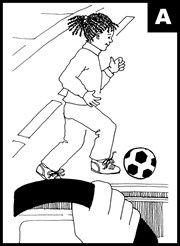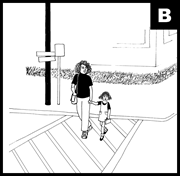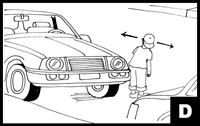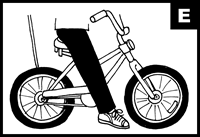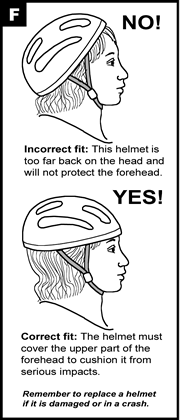TIP #8: KIDS ON THE MOVE: WALKING AND BIKING SAFELY
LEARNING TO BE TRAFFIC SMART
Children in kindergarten through third grades (5 to 10 years old) are learning to become independent. They enjoy walking, riding bikes, and playing outside. They don't have the judgment to cope with traffic by themselves yet, but they can begin to understand safety rules.
WHAT PARENTS NEED TO KNOW:
- Parents often think their children are able to handle
traffic safely by themselves before they are actually ready.
- Children
don't have the skills to handle these risky situations until about
age 10.
- Boys are much more likely than girls to be injured
or killed in traffic, on average boys take more risks.
- Bicycles are
vehicles. Children should not ride bikes in the road until they fully
understand traffic rules and show they can follow them.
- Children
often act before thinking and may not do what parents or drivers
expect.
- Children assume that if they see the driver, the driver
sees them.
- Children can't judge speed and they think cars can
stop instantly.
- Children are shorter than adults and can't see over
cars, bushes, and other objects.
WALKING RISKS
|
||
|
||
|
Nearly one-third of the 5 to 9 year old children killed
by motor vehicles are onfoot. They are hit by cars most often when playing
near home. They tend to run into the street in the middle of the block,
where drivers don't expect them (A).
BICYCLING RISKS
Children can be hurt riding on or off the road. Most children who are killed in bike crashes are 7 to 12 years old. The most serious injuries children get while biking are head and brain injuries. These injuries can cause death or lifelong disability.
TAKE THESE STEPS TO SAFETY:
- Set limits for your child
As your children grow, set appropriate limits on where they can walk or bike safely. Don't expect them to be responsible or to start to behave safely until about age 10.
- Teach
safe walking habits
Begin to teach your child how to cross streets safely (click here). Give them plenty of chances to practice when you are with them (B).
- Find safe places for bicycling and walking
Find places away from streets, driveways, and parking lots. Good choices are fenced yards, parks, trails/paths, or playgrounds.
- Set an example yourself
Young children learn by watching their parents and other adults. Cross streets properly and always wear a helmet when you ride a bike (C). When you are driving, obey speed limits, wear your safety belt and watch for children. Allow your children the opportunity to practice safe walking and riding when you are with them.
TEACH THE "SAFE STREET CROSSING" METHOD. TEACH YOUR CHILD TO:
- Cross with an adult or older friend. (Young children
still need supervision around traffic up to about age 10).
- Cross at
an intersection where there are signals.
- Use the crosswalk when crossing
near a corner. Watch for turning vehicles.
- Stop at the curb. Look
left, right, left, and over your shoulder for traffic. Continue to
look as you cross the street.
- Stop to look around parked cars or
other objects that block the view of traffic (D). Let oncoming traffic
pass, then look again before crossing. as you cross.
- Make eye contact
with drivers to make sure they see you.
HELP YOUR CHILD BIKE SAFELY:
- A kid-size bike is right
A big bike "to grow into" is not easy to learn on or to ride safely. A child should be able to sit on the seat with knees straight and feet flat on the ground (E). Also make sure the child can straddle the bike with at least one or two inches between the top bar and the child's crotch.
- Insist on bike helmet
use
A brain injury cannot be cured! Bike helmets can reduce the risk of head injury by 85 percent when worn correctly. Make it clear to your child that she/he must wear a helmet on every ride. It also is important to wear a helmet when doing other sports, like in-line skating and skateboarding.
SELECTING AND FITTING A BIKE HELMET
- Every new helmet must meet the Consumer Product Safety
Commission (CPSC) Standard and display a label stating that it meets
the standard. On older helmets, look for a CPSC , ASTM1, ANSI2, or
Snell3 sticker inside the helmet.
- Use foam pads inside to fit the helmet
snugly so it doesn't move on the head.
- Fit the helmet so the front
is two finger widths above the eyebrows. Teach your child to wear
their helmet the correct way (F).
- Adjust the two side straps so they
meet in a "V" right
under each ear.
- Adjust the chin strap snugly under the chin. Make
it tight enough so the helmet pulls down when the child opens his mouth.
- Check often to make sure straps stay snug and the helmet stays level
on the head.
ENCOURAGE YOUR CHILD TO WEAR HIS/HER HELMET
- Let your child help choose the helmet.
- Explain that a helmet is "just
part of the gear," as
it is with football, race car driving, or hockey.
- Praise your child for
wearing his/her helmet.
- Talk to other parents, so that all neighborhood
families encourage the same safety rules.
- Be a role model and wear your bike helmet.
1American Society for Testing and Materials
2American National Standards Institute
3Snell Memorial Foundation
 |
For more information, contact the DOT Auto Safety Hotline at 1-888-DASH-2-DOT (1-888-327-4236) or www.nhtsa.dot.gov Illustrations from Indiana University School of Medicine |
